I've been looking recently for information regarding th Mortuary sword but have not been able to find a lot of it on the internet. I was hoping you could teach me a few things about this type of swords development. What influenced it and how did it come into being? What sorts of other swords are related to it? Where and when was it used? how long did it stay in use? Was it used all over Europe or only in the UK? Why is it called a Mortuary sword anyway?
thanks my first post
As I'm too lazy to type this morning I'll just refer you to our old friend, Piquet ....
From: Ewart Oakeshott's fine book "European Weapons & Armour" , copyright 1980 by R. Ewart Oakeshott.
(he's a little more detailed than I am anyways ;-) Mac
[ Linked Image ]
[ Linked Image ]
[ Linked Image ]
From: Ewart Oakeshott's fine book "European Weapons & Armour" , copyright 1980 by R. Ewart Oakeshott.
(he's a little more detailed than I am anyways ;-) Mac
[ Linked Image ]
[ Linked Image ]
[ Linked Image ]
Hi ya Adam,
Mortuary's.....ah a man after my own heart. I'm obsessed with Mortuary's and have been collecting
any kinda data, (pics, articles,books,SWORDS, & etc) for quite some time. If you have any more specific questions
please feel free to PM me. I'll be happy to help. BTW welcome!
Here's a comparison pic of my Armour Class & Paul Chen Mortuary's
Bill
aka William
 Attachment: 26.88 KB
Attachment: 26.88 KB
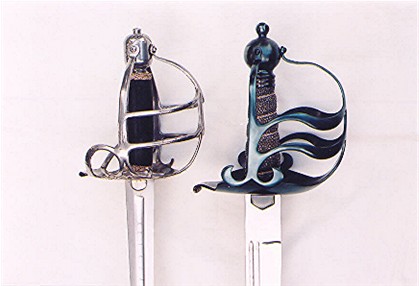
Mortuary's.....ah a man after my own heart. I'm obsessed with Mortuary's and have been collecting
any kinda data, (pics, articles,books,SWORDS, & etc) for quite some time. If you have any more specific questions
please feel free to PM me. I'll be happy to help. BTW welcome!
Here's a comparison pic of my Armour Class & Paul Chen Mortuary's
Bill
aka William

Hi Adam,
Here's some photo help. In the article that Thomas posted above, find the reference to the Mort in the Tojhhusmseet: this sword is shown in the article by Hayward on English swords that you'll find here on myArmoury under the Features heading.
The curved blade Mort referred to can be seen in the book by Claude Blair entitled "European and American Arms".
If you can find the book "The Price Guide to Antique Edged Weapons", you'll find 3 pages of photos of various Mort types.
I'll try to get to the school's scanner tomorrow and scan the pages of Morts in "European Swords and Daggers in the Tower of London" (Bill, I was going to send these pages to you, but will post them here for all to see).
--ElJay
Here's some photo help. In the article that Thomas posted above, find the reference to the Mort in the Tojhhusmseet: this sword is shown in the article by Hayward on English swords that you'll find here on myArmoury under the Features heading.
The curved blade Mort referred to can be seen in the book by Claude Blair entitled "European and American Arms".
If you can find the book "The Price Guide to Antique Edged Weapons", you'll find 3 pages of photos of various Mort types.
I'll try to get to the school's scanner tomorrow and scan the pages of Morts in "European Swords and Daggers in the Tower of London" (Bill, I was going to send these pages to you, but will post them here for all to see).
--ElJay
Hey Eljay,
Yes, please do post those photos when you can or can still just send them to me.... ;)
Adam,
Another good resource of info. on Mortuary's and that time period is "Arms & Armour of the English Civil Wars" by
David Blackmore. Also, for a few more pics, you can look on the ALBUMS section of this site, click on user albums and go to my album. This is just a small amount that I have, compared to what I've amassed on the PC here at home.
Bill
aka William
Yes, please do post those photos when you can or can still just send them to me.... ;)
Adam,
Another good resource of info. on Mortuary's and that time period is "Arms & Armour of the English Civil Wars" by
David Blackmore. Also, for a few more pics, you can look on the ALBUMS section of this site, click on user albums and go to my album. This is just a small amount that I have, compared to what I've amassed on the PC here at home.
Bill
aka William
I finally got to the scanner today, so here's some photos.
The first is two shots of the sword that Cromwell supposedly used at Drogheda.
The others are single shots of some very high quality Morts, although some show some damage.
There was one more page, but it just had a photo of a very worn pierced hilt, and a munitions-grade sword rather like the ones Bill has provided photos of.
--ElJay
 Attachment: 17.33 KB
Attachment: 17.33 KB
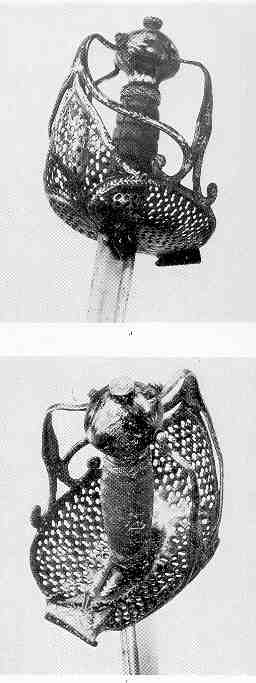
 Attachment: 35.94 KB
Attachment: 35.94 KB
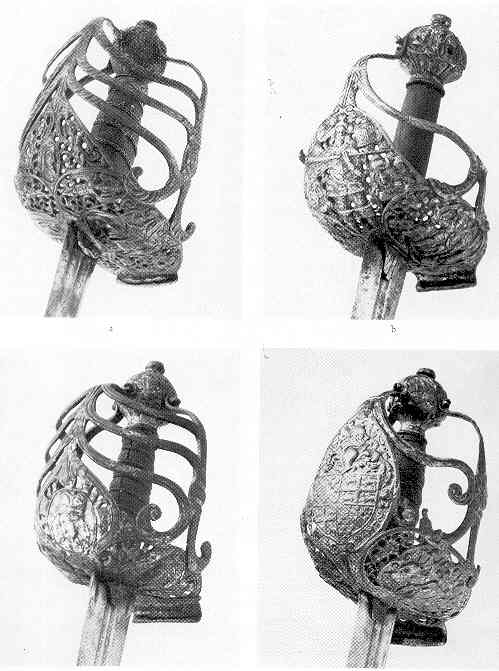
The first is two shots of the sword that Cromwell supposedly used at Drogheda.
The others are single shots of some very high quality Morts, although some show some damage.
There was one more page, but it just had a photo of a very worn pierced hilt, and a munitions-grade sword rather like the ones Bill has provided photos of.
--ElJay


Hi Eljay
Just for the reference record ......
I added a bunch of those pictures, of the Mort's, proto-Mort's, baskets, hangers, etc., that Stephen Fisher had sent me (probably via you ) to this album http://www.myArmoury.com/albums/thumbnails.ph...amp;page=1
Mac
Just for the reference record ......
I added a bunch of those pictures, of the Mort's, proto-Mort's, baskets, hangers, etc., that Stephen Fisher had sent me (probably via you ) to this album http://www.myArmoury.com/albums/thumbnails.ph...amp;page=1
Mac
I finally got to a scanner, so here's some photos from the book "European Swords and Daggers in the Tower of London".
The first one is two shots of the sword that Cromwell supposedly carried at Drogheda.
The grouping of four are all very high quality Morts, although one has some damage.
There was one more page of pictures, but it only had a very worn pierced hilt, and one very simple munitions-grade sword that's similar to Bills' modern replicas.
--ElJay
 Attachment: 17.33 KB
Attachment: 17.33 KB
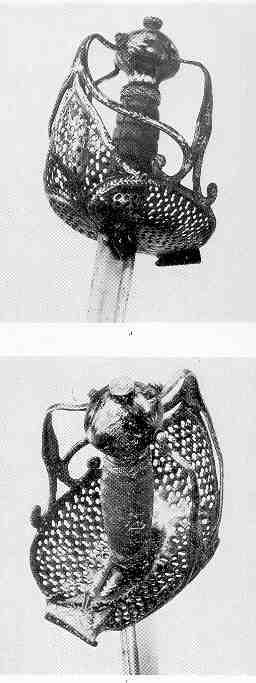
 Attachment: 35.94 KB
Attachment: 35.94 KB
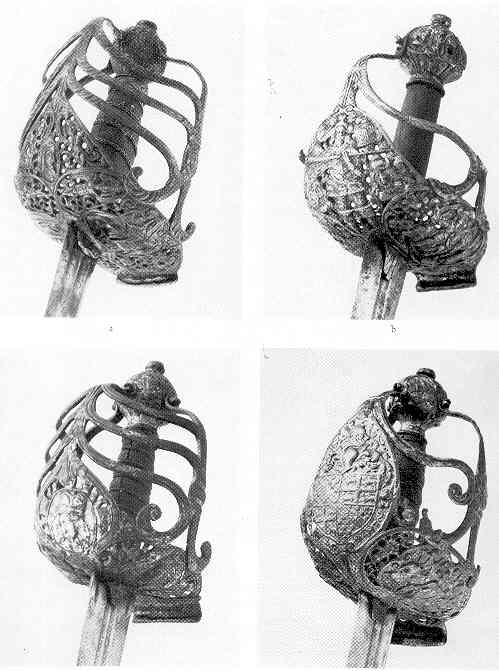
The first one is two shots of the sword that Cromwell supposedly carried at Drogheda.
The grouping of four are all very high quality Morts, although one has some damage.
There was one more page of pictures, but it only had a very worn pierced hilt, and one very simple munitions-grade sword that's similar to Bills' modern replicas.
--ElJay


Armour Class does a spot - on replica of the Cromwell / Drogheda Mortuary....would love to have one of those in my collection.
Bill
 Attachment: 19.32 KB
Attachment: 19.32 KB
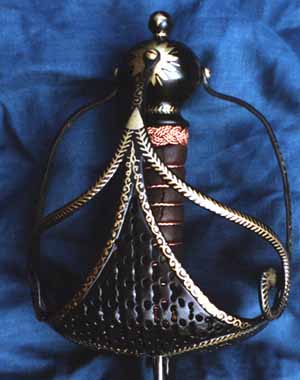
Bill

Hi Thomas,
Thanks for the link to the photos! While I do have photos of a lot of those swords, Stephen dug all those up himself. There were a couple of the "proto-morts" that I hadn't seen; that gold-plated version was pretty cool!
--ElJay
Thanks for the link to the photos! While I do have photos of a lot of those swords, Stephen dug all those up himself. There were a couple of the "proto-morts" that I hadn't seen; that gold-plated version was pretty cool!
--ElJay
Most , if not all these pics are also found in David Blackmore's "Arms & Armour of the English Civil Wars" that I mentioned earlier. This is a great reference book for anyone interested in the ECW.
Bill
Bill
I just noticed that Manning Imperial has posted a new Mortuary Hilted Sword on the site. It's quite nice. Check it out:
[ Linked Image ]
[ Linked Image ]
Ooooo....thanks for the heads up on this Nathan. Went to Manning site and checked it out. Very nicely done repro of the Royal Armouries I X 2205 Mort. The blade markings are more precise than the Paul Chen version and the basket seems to be a little larger , too. As for the price tag....seems a wee bit over-board. I feel this is due to the legallity issues Australia is dealing with now, concerning edged weapons.
Cheers,
Bill
aka William
Cheers,
Bill
aka William
I actually doubt that, with Craigs work the more accurate and better made the blade is the higher the price...cause he makes alot of $300ish beaters that are no where near as impressive. thats $2,377.80 USD so I'd say thats kinda fair for such a piece...
Excuse my potentially stupid question, but how exactly are these different than walloon swords? They look like they're just a different version of a walloon. am i off-based? are they related? is one a version of or grown into the other??
thanks for indulging my questions
thanks for indulging my questions
Hey Adam,
To some extent, some may say they are related and that the "mortuary" is a evolution of the Walloon.
E. Oakeshot describes it (The Walloon) as "stemmed orginally from the English Hilt E." in the European Weapons and Armour book.
Bill
To some extent, some may say they are related and that the "mortuary" is a evolution of the Walloon.
E. Oakeshot describes it (The Walloon) as "stemmed orginally from the English Hilt E." in the European Weapons and Armour book.
Bill
Last edited by William Goodwin on Fri 19 Nov, 2004 4:18 am; edited 2 times in total
Hi Adam,
That's not a stupid question at all, because the Walloons and Morts DO look similar at first glance, and it's the presence of the side knucklebows that make them look similar. However, they are of very different construction. Walloons have two heart-shaped guards filled with pierced plates. The guards are attached to a quillon block, which reflects earlier rapier hilt construction. Mort guards are of a single dished plate. The grip usually sits on an odd mount with tongues that protrude through the guard (they look like little langets). Because of these construction differences, I think the two types originated independently.
I am also of the opinion that the Mort was the first to be developed, as they're a well-established English type by the 1630s, yet the classical Walloon apparently doesn't show up until around 1650.
There are Mort hilts that show some Walloon influence, but I think that these date at the earliest from the 1650s.
--ElJay
That's not a stupid question at all, because the Walloons and Morts DO look similar at first glance, and it's the presence of the side knucklebows that make them look similar. However, they are of very different construction. Walloons have two heart-shaped guards filled with pierced plates. The guards are attached to a quillon block, which reflects earlier rapier hilt construction. Mort guards are of a single dished plate. The grip usually sits on an odd mount with tongues that protrude through the guard (they look like little langets). Because of these construction differences, I think the two types originated independently.
I am also of the opinion that the Mort was the first to be developed, as they're a well-established English type by the 1630s, yet the classical Walloon apparently doesn't show up until around 1650.
There are Mort hilts that show some Walloon influence, but I think that these date at the earliest from the 1650s.
--ElJay
To me,the Walloon has always had a closer tie to 18th c. smallswords as far as hilt construction and blade type.
Alot of folks are under the impression that basket-hilts (of any sort) didn't show up until the 1700's and are of strictly Scottish origin. Then when explained they've been around since sometime in the 1500's and are of English and German influence, it just pops their noodle.
Bill
Alot of folks are under the impression that basket-hilts (of any sort) didn't show up until the 1700's and are of strictly Scottish origin. Then when explained they've been around since sometime in the 1500's and are of English and German influence, it just pops their noodle.
Bill
Last edited by William Goodwin on Fri 19 Nov, 2004 4:19 am; edited 1 time in total
| William Goodwin wrote: |
| Hey Adam,
To some extent, some may say they are related and that the "mortuary" is a evolution of the Wallon. E. Oakeshot describes it (The Wallon) as "stemmed orginally from the English Hilt E." in the European Weapons and Armour book. Bill |
is that book commonly available still or out of print?
Adam,
It should be readily available from Amazon, Barnes & Noble and other book sellers. Great book for reference.
Bill
It should be readily available from Amazon, Barnes & Noble and other book sellers. Great book for reference.
Bill
Page 1 of 2
You cannot post new topics in this forumYou cannot reply to topics in this forum
You cannot edit your posts in this forum
You cannot delete your posts in this forum
You cannot vote in polls in this forum
You cannot attach files in this forum
You can download files in this forum
All contents © Copyright 2003-2006 myArmoury.com — All rights reserved
Discussion forums powered by phpBB © The phpBB Group
Switch to the Full-featured Version of the forum
Discussion forums powered by phpBB © The phpBB Group
Switch to the Full-featured Version of the forum